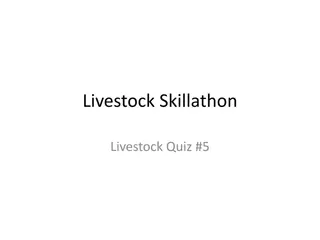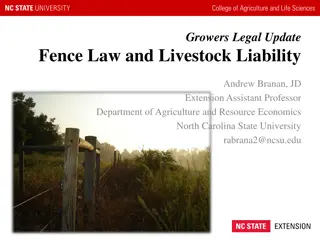Mobilizing Juncao Technology for Livestock Production in Nigeria
Nigeria, a country with vast land mass and a significant youth population, faces challenges such as desertification and ecological threats. Livestock agriculture plays a crucial role in the economy, providing food security, employment, and income. The adoption of Juncao technology, as presented at a workshop in Addis Ababa, offers a sustainable solution to enhance livestock production in Nigeria and mitigate environmental degradation.
Download Presentation

Please find below an Image/Link to download the presentation.
The content on the website is provided AS IS for your information and personal use only. It may not be sold, licensed, or shared on other websites without obtaining consent from the author. Download presentation by click this link. If you encounter any issues during the download, it is possible that the publisher has removed the file from their server.
E N D
Presentation Transcript
Mission of the Peoples Republic of China to the African Union Mobilizing Juncao Technology for Livestock Production in Nigeria Prof. Gurama Abubakar Umar Federal University of Kashere, Gombe State-Nigeria. Presented at Second Regional Workshop on Applications of Juncao Technology and it s Contribution to the Achievement of Sustainable Agriculture and the Sustainable Development Goals in Africa UNCC-ADDIS ABABA 2023
INTRODUCTION Nigeria is located in West Africa It has total land mass of 923, 769 square kilometers It has an estimated population of 223,804,632 Rank Six most populous country in the world It has one of the largest youth population in the world with about 70% under the age of 30 years It an agrarian society with about 70% of the population involved in agricultural value chain Map of Africa Showing Nigeria
Ecological zones There are Six Ecological Zones The Vegetation cover increases from North to South The Sahel and Sudan Savannah are threatened by desert encroachment About 10 States in the Northern fringes are threatened by desertification Ecological Zones
Desertification has affected an estimated population of over 50million Nigerians Causes of Desertification Overgrazing Deforestation Intensive farming practices Climate Change Desertification in Nigeria
Importance of Livestock Agriculture is the most important sector to Nigerian economy after oil. Livestock production is very essential to food security and development of any nation. It provide foreign exchange for the economy Employment opportunities Rich source of protein which is essential to human nutrition. Source of income Provide raw materials to agro industry Provide draught power Source of prestige
Livestock Population in Nigeria 22,378,374 53,061,143 The Estimated Livestock Population in Nigeria in 2022 Cattle: 22,378,374 Sheep: 53,061,143 Goats: 99,879,799 Pigs: 9,299,563 Poultry: 425,790,456 99,879,799 9,299,563 425,790,456 Cattle Sheep Goats Pigs Poultry
The bulk of livestock breeders come from the Sahel, Sudan and Northern Guinea savannah ecological zones of Nigeria Livestock production in Nigeria is characterized by nomadic pastoralism Pastoralism is a form of animal husbandry where livestock are released onto large vegetated outdoor land for grazing There are 15million pastoralists in Nigeria with over 82% of cattle population
Some Challenges of Livestock Production in Nigeria Lack of pasture and quality feed High cost of animal feeds Seasonal feed shortages Scarcity of water resources Shortages of grazing land Urbanization Climate change Insecurity
Nigeria has had very laudable agricultural policies and schemes, but food security has not been guaranteed The solution to some of the challenges to livestock production lies with the Juncao technology Juncao grass
Juncao Technology Adoption Strategies Juncao Awareness Interest Adoption Trial Factors Influencing Adoption of an innovation Relative advantage Compatibility Complexity Trialability Adoption
Methods of Mobilization Used Individual/Household approach The group approach The school approach Mass media approach
Individual Approach Cont. Technology Outreach Centers
Group Approach Meeting with traditional leaders and herders associations
School Approach Added Juncao Technology to undergraduate curriculum FUK-AGR 309: Principles and Practices of Juncao Technology (2 Units; Core; L = 15; P = 45) Senate-approved relevance Training of high-quality graduates who are highly skilled and knowledgeable in Juncao grass production, processing and utilization which is in agreement with FUK s mission to address African food and nutrition challenges through sound agricultural practices. Relevance is seen in agricultural graduates from FUK being able to develop good Agricultural practices in tandem with global best practices to reduce hunger, poverty and create jobs.
Overview Juncao technology is an innovation developed by National Engineering Research Centre for Juncao Technology of Fujian Agriculture and Forestry University (FAFU) of China that promotes feed production for livestock, mushroom production, climate mitigation and as a source of energy. It is an important technology used in reducing unemployment, hunger and poverty by providing practical knowledge and skills in the area of animal feed production, mushroom production and climate smart agriculture. This highlights the importance of preparing graduates of agriculture with the knowledge and skills on how to train livestock and mushroom farmers for economic development. This course is designed to expose students to various principles and practices of Juncao technology. Also, to build the capacity of students in the area of addressing food and nutrition crisis in Nigeria. The importance of the course lies in meeting the need in achieving sustainable development goals (SDGs) in the areas of poverty reduction, zero hunger, job creation, and climate action issues. The objectives of the course, learning outcomes, and contents are provided to address these needs.
Objectives The objectives of the course are to: provide opportunities to learn basic agricultural skills and knowledge, agricultural business training and retraining, and professional growth and development. provide up-to-date technical skills and knowledge in Juncao grass production and utilization. conduct experiential learning activities in the world of agriculture. involve students in leadership and personal development activities at the local, state, and national levels. develop agricultural competencies needed by individuals engaged in or preparing to engage in production agriculture. develop agricultural competencies needed by individuals engaged in or preparing to engage in agricultural business other than production agriculture. develop an understanding of, and appreciation for, career opportunities in agriculture and the preparation needed to enter and progress in agricultural business. develop those abilities in human relations that are essential in agricultural business. develop the abilities needed to exercise and follow effective leadership in carrying out occupational, social, and civic responsibilities. 1. 2. 3. 4. 5. 6. 7. 8. 9.
Learning outcomes On completion of the course, students should be able to: learn basic agricultural skills and knowledge, agricultural business training and retraining, and professional growth and development. discuss up-to-date technical skills and knowledge in Juncao grass production and utilization. apply the juncao technology to improve food and nutrition in Nigeria. embrace leadership and personal development activities at the local, state, and national levels. develop agricultural competencies needed by individuals engaged in production agriculture. use juncao technology to generate sustainable income, reduce hunger and climate mitigation. improve an understanding of, and appreciation for, career opportunities in agriculture and the preparation needed to enter and progress in agricultural business. express those abilities in human relations that are essential in agricultural business. understand the abilities needed to exercise and follow effective leadership in carrying out occupational, social, and civic responsibilities. 1. 2. 3. 4. 5. 6. 7. 8. 9.
Course Content What is Juncao Technology, Scope and concept of juncao technology, principles of juncao technology, production of juncao grass; site selection, land preparation, planting, agronomic practices, water requirements, harvesting, processing and utilization. Juncao grass improvement; tissue culture, breeding and genetic engineering. Livestock feed production, preparation and utilization, hay and silage production. Juncao grass and mushroom production practices; harvesting, drying, blending, tube production, sterilization, inoculation and incubation. Mushroom harvesting, packaging and storage. Utilization of spent substrate. Nutritional importance of edible mushroom and types. Climate mitigation; overgrazing, desertification and soil conservation practices. Biofuel production, charcoal production. Industrial uses of juncao grass. Role of juncao technology in Nigerian economy. Minimum Academic Standards Crop and Livestock Farm and Laboratory in line with the NUC-CCMAS required facilities teaching and learning in Agriculture.
School Approach Cont Engaging some selected primary school pupils Collaboration with Universities and Agricultural training schools Collaboration with Federal and State Ministries of Agriculture
Mass Media Approach Through Electronic Media Radio and TV Broadcast
Engaging Government officials Kano State Government has established 317 hectares at Dansoshiya grazing reserve Kebbi State Government has established 5 hectares of Juncao grass Gombe State Government will establish 10 hectares of Juncao grass Federal Ministry of Agriculture has established 3.5 ha of Juncao grass. Dansoshiya Grazing Reserve Kano State
Juncao Grass Planting at Dan soshiya Grazing Reserve Kano State Juncao grass at Dansoshiya Grazing Reserve Kano State
Challenges Inadequate planting materials Funding Poor coordination of Juncao farmers Seasonal rainfall
Further Research Breeding an edible Juncao grass Crossing Gamba grass with Juncao grass to produce a hybrid that can tolerate burning, overgrazing and low moisture. Gamba Grass (Andropogon gayanus)
Appreciation I want to most sincerely thank and appreciate National Engineering Research Centre for Juncao Technology of Fujian Agriculture and Forestry University of China for the online training on Juncao technology between 26th August and 24th September, 2022. I equally want to thank UNDESA and FAFU for sponsoring by visit to Rwanda and China in February and June, 2023 respectively. I also wish to thank the Mission of the People s Republic of China to the African Union, UNDESA and FAFU for making it possible for me to come to Addis Ababa to participate in the second regional workshop on Juncao technology. I am grateful to Prof Lin Zhanxi, Chief Scientist of China National Engineering Research Centre of Juncao Technology, FAFU and his team for creating Juncao Technology for the entire mankind.























